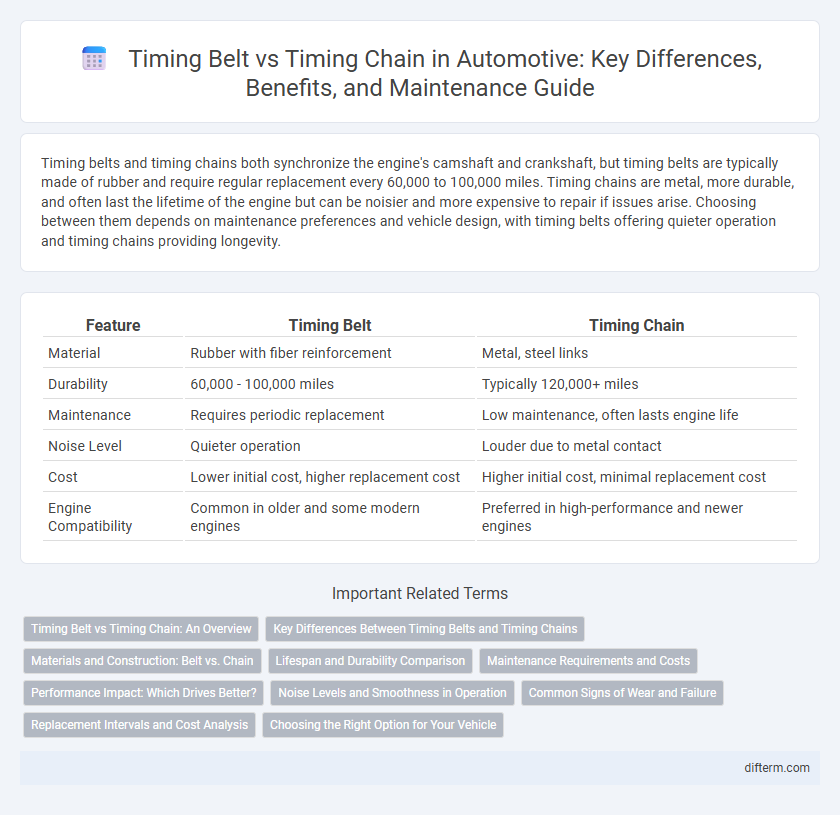Timing belts and timing chains both synchronize the engine's camshaft and crankshaft, but timing belts are typically made of rubber and require regular replacement every 60,000 to 100,000 miles. Timing chains are metal, more durable, and often last the lifetime of the engine but can be noisier and more expensive to repair if issues arise. Choosing between them depends on maintenance preferences and vehicle design, with timing belts offering quieter operation and timing chains providing longevity.
Table of Comparison
| Feature | Timing Belt | Timing Chain |
|---|---|---|
| Material | Rubber with fiber reinforcement | Metal, steel links |
| Durability | 60,000 - 100,000 miles | Typically 120,000+ miles |
| Maintenance | Requires periodic replacement | Low maintenance, often lasts engine life |
| Noise Level | Quieter operation | Louder due to metal contact |
| Cost | Lower initial cost, higher replacement cost | Higher initial cost, minimal replacement cost |
| Engine Compatibility | Common in older and some modern engines | Preferred in high-performance and newer engines |
Timing Belt vs Timing Chain: An Overview
Timing belts are made of reinforced rubber, offering quieter operation and typically requiring replacement every 60,000 to 100,000 miles, while timing chains are metal, more durable, and often last the vehicle's lifetime with minimal maintenance. Timing belts drive the camshaft to synchronize engine valves, but their replacement schedule is critical to prevent engine damage, whereas timing chains provide higher strength and longevity but can be noisier over time. Choosing between a timing belt and timing chain depends on factors such as engine design, vehicle maintenance costs, and manufacturer recommendations.
Key Differences Between Timing Belts and Timing Chains
Timing belts, typically made of reinforced rubber, require replacement every 60,000 to 100,000 miles, whereas timing chains, constructed from metal, are more durable and often last the vehicle's lifetime. Timing belts operate more quietly and offer lighter engine components, while timing chains provide stronger resistance to heat and wear. Maintenance costs for timing belts tend to be higher due to periodic replacements, but timing chains can cause significant engine damage if failure occurs.
Materials and Construction: Belt vs. Chain
Timing belts are typically made from reinforced rubber compounds with fiberglass or Kevlar cords, offering flexibility and quiet operation, while timing chains are constructed from hardened steel links designed for durability and high tensile strength. The rubber material of belts provides smoother engine performance but requires regular replacement due to wear and heat degradation. Steel chains, though noisier and heavier, offer longer lifespan and greater resistance to stretching under high-stress conditions in high-performance or heavy-duty engines.
Lifespan and Durability Comparison
Timing belts typically last between 60,000 to 100,000 miles and require periodic replacement due to wear and potential snapping, while timing chains often last 150,000 miles or more owing to their metal construction and greater durability. Timing chains are more resistant to heat and stretching compared to timing belts, making them a preferred choice for high-performance and long-lasting engine designs. However, timing chains may demand more complex and costly repairs if they fail, despite their generally superior lifespan.
Maintenance Requirements and Costs
Timing belts require regular replacement typically every 60,000 to 100,000 miles, with maintenance costs ranging from $300 to $700 due to labor-intensive procedures. Timing chains are more durable, often lasting the vehicle's lifetime, but repair or replacement can be costly, sometimes exceeding $1,000, given their complex integration in the engine. Routine inspections for timing chains are less frequent, reducing maintenance expenses over time compared to timing belts.
Performance Impact: Which Drives Better?
Timing belts offer quieter operation and lighter weight, contributing to smoother engine performance and improved fuel efficiency. Timing chains provide increased durability and resistance to stretching, ensuring consistent valve timing for high-performance engines under demanding conditions. Vehicles with timing chains generally experience better long-term performance reliability, while timing belts offer optimized efficiency in standard driving environments.
Noise Levels and Smoothness in Operation
Timing belts operate with significantly lower noise levels compared to timing chains, as their rubber construction absorbs vibrations and reduces mechanical clatter. Timing chains, made from metal links, inherently produce more noise during engine operation due to chain slap and tensioner noise. Smoothness in operation favors timing belts, delivering quieter, vibration-free performance, whereas timing chains may cause subtle roughness and require periodic tension adjustments to maintain optimal smoothness.
Common Signs of Wear and Failure
Common signs of timing belt wear include visible cracks, fraying, and missing teeth, often accompanied by engine misfires or rough idling. Timing chain failure typically presents as rattling noises from the engine, especially during startup, along with poor engine performance and a check engine light. Both components are critical to engine timing and require prompt attention to prevent severe engine damage.
Replacement Intervals and Cost Analysis
Timing belts typically require replacement every 60,000 to 100,000 miles, while timing chains often last over 150,000 miles with less frequent replacement. The cost of timing belt replacement ranges from $500 to $1,000, including labor and parts, whereas timing chain replacements can cost between $1,000 and $2,500 due to more complex labor. Considering the longer lifespan but higher replacement cost, timing chains offer better long-term value despite a higher initial servicing price.
Choosing the Right Option for Your Vehicle
Selecting the right timing belt or timing chain depends on your vehicle's make, model, and engine type, with timing belts offering quieter operation and cost-effective replacements while timing chains provide greater durability and longevity. Timing belts typically require replacement every 60,000 to 100,000 miles, whereas timing chains often last the life of the engine but may necessitate expensive repairs if they fail. Consulting your vehicle manufacturer's recommendations and considering factors like maintenance costs, engine design, and performance needs ensure optimal engine timing and reliability.
timing belt vs timing chain Infographic

 difterm.com
difterm.com